|
|
|
Sort Order |
|
|
|
Items / Page
|
|
|
|
|
|
|
| Srl | Item |
| 1 |
ID:
131521
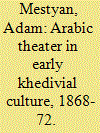

|
|
|
|
|
| Publication |
2014.
|
| Summary/Abstract |
This article revisits the official culture of the early khedivate through a microhistory of the first modern Egyptian theater in Arabic. Based on archival research, it aims at a recalibration of recent scholarship by showing khedivial culture as a complex framework of competing patriotisms. It analyzes the discourse about theater in the Arabic press, including the journalist Muhammad Unsi's call for performances in Arabic in 1870. It shows that the realization of this idea was the theater group led by James Sanua between 1871 and 1872, which also performed ?Abd al-Fattah al-Misri's tragedy. But the troupe was not an expression of subversive nationalism, as has been claimed by scholars. My historical reconstruction and my analysis of the content of Sanua's comedies show loyalism toward the Khedive Ismail. Yet his form of contemporary satire was incompatible with elite cultural patriotism, which employed historicization as its dominant technique. This revision throws new light on a crucial moment of social change in the history of modern Egypt, when the ruler was expected to preside over the plural cultural bodies of the nation.
|
|
|
|
|
|
|
|
|
|
|
|
|
|
|
|
| 2 |
ID:
131518
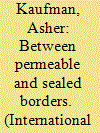

|
|
|
|
|
| Publication |
2014.
|
| Summary/Abstract |
The Trans-Arabian Pipeline (Tapline), which extended from Dhahran in Saudi Arabia to Zahrani in Lebanon and operated from 1950 to 1982, was haunted by the Arab-Israeli conflict throughout the years of its operation. The route of the pipeline-which traversed Saudi Arabia, Jordan, Syria, and Lebanon-was chosen so as to circumvent Palestine/Israel. However, following the Israeli occupation of the Golan Heights in the 1967 war, Israel became an active participant in this project, with the full consent of the transit states and Egypt. This article uses Tapline as a means to analyze the interconnected world facilitated by oil pipelines, which defies common wisdom about state sovereignty or the function of interstate boundaries. In addition, Tapline demonstrates how this interconnected network created possibilities for Arab-Israeli cooperation that might have seemed inconceivable initially, given the hostile dynamics of the conflict.
|
|
|
|
|
|
|
|
|
|
|
|
|
|
|
|
| 3 |
ID:
131549
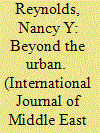

|
|
|
|
|
| Publication |
2014.
|
| Summary/Abstract |
Studies of public space focus disproportionately on cities. Complex and densely populated urban built environments-with their streets, plazas, institutional buildings, housing projects, markets-make concrete and visible attempts to manage difference. They also structure the ways that less powerful residents challenge and sometimes remake elites' spatial visions of the social order. The robust literature in Middle East studies on Islamic cities, colonial cities, dual cities, quarters and ethnicities, port cities, and so forth is no exception to this urban focus.
|
|
|
|
|
|
|
|
|
|
|
|
|
|
|
|
| 4 |
ID:
131516
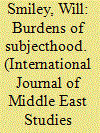

|
|
|
|
|
| Publication |
2014.
|
| Summary/Abstract |
This article analyzes the changing treaty law and practice governing the Ottoman state's attitude toward the subjects of its most important neighbor and most inveterate rival: the Russian Empire. The two empires were linked by both migration and unfreedom; alongside Russian slaves forcibly brought to the sultans' domains, many others came as fugitives from serfdom and conscription. But beginning in the late 18th century, the Ottoman Empire reinforced Russian serfdom and conscription by agreeing to return fugitives, even as the same treaties undermined Ottoman forced labor by mandating the return of Russian slaves. Drawing extensively on Ottoman archival sources, this article argues that the resulting interimperial regulations on unfreedom and movement hardened the empires' human and geographic boundaries, so that for many Russian subjects, foreign subjecthood under treaty law was not a privilege, but a liability.
|
|
|
|
|
|
|
|
|
|
|
|
|
|
|
|
| 5 |
ID:
131544


|
|
|
|
|
| Publication |
2014.
|
| Summary/Abstract |
Aspects of space and place shape daily life, social structures, politics, and intimate relations among people. In the late 1980s and 1990s, anthropologists, geographers, and sociologists-influenced by the writings of Michel Foucault and Henri Lefebvre on the meaning of social space-started to highlight the spatial in their analysis of social phenomena. These scholars focused on the production of urban space and asserted that space is dynamic and often shaped by the needs of its users as well as by those who design it. With the exception of Setha Low's work on Latin America, these writings were mostly centered on the United States.
|
|
|
|
|
|
|
|
|
|
|
|
|
|
|
|
| 6 |
ID:
131515
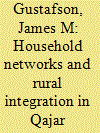

|
|
|
|
|
| Publication |
2014.
|
| Summary/Abstract |
The governorships of Muhammad Isma?il Khan Vakil al-Mulk (1859-68) and Murtaza Quli Khan Vakil al-Mulk II (1868-78) in Qajar Kirman were highlighted by an extensive building campaign which initiated a period of significant social and economic change in the province. This article explores the activities of local elites in managing their family estates in the context of this project through a careful analysis of provincial geographical and historical writings, Persian-language travelogues, and commentary by European administrators and travelers. Kirmani elites began investing in land and commercial agriculture on an unprecedented scale, accelerating Kirman's absorption into global economic patterns as a producer of raw materials like cotton, wool, and opium. An integrated political economy developed regionally through the expanding networks of elite households and their estates, reinforced by families combining landownership with administrative functions in rural areas. This process demonstrates the extent to which Iranians were active participants in transforming their communities in the context of the advance of global capitalism, with longstanding patterns of elite household competition playing an important role in mediating social and political change locally.
|
|
|
|
|
|
|
|
|
|
|
|
|
|
|
|
| 7 |
ID:
131538
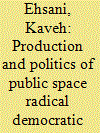

|
|
|
|
|
| Publication |
2014.
|
| Summary/Abstract |
These are critical times for democratic politics from Morocco to Iran, as heterogeneous popular movements for greater representation and social justice increasingly challenge established authorities. It is not surprising that these struggles have laid claim to symbolic urban places in the process of claiming their collective political demands. Politics is not purely discursive or institutional; it always has material and spatial dimensions, which for democratic politics is manifested through public space. For all the recent enthusiasm about the emancipating possibilities of the digital media, the fact remains that Tahrir Square (Cairo), Gezi Park (Istanbul), Revolution Street (Tehran), and Pearl Roundabout (Manama) are not virtual locations on the Internet.
|
|
|
|
|
|
|
|
|
|
|
|
|
|
|
|
| 8 |
ID:
131534
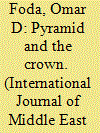

|
|
|
|
|
| Publication |
2014.
|
| Summary/Abstract |
This paper focuses on a long-running and understudied Egyptian economic institution, the beer industry. While the presence of a well-developed beer industry in a predominantly Muslim country is noteworthy in itself, it is the consistent profitability of this industry despite the vicissitudes of Egypt's economic and political development that have made it truly remarkable. Relying heavily on archival material, including documents preserved in Cairo's Dar al-Watha?iq (Egyptian National Archives), this paper tracks the development of the beer industry in Egypt from 1897, when Belgian entrepreneurs started the Pyramid and Crown breweries, to the 1960s, when the Egyptian government nationalized the two companies. This analysis uses the history of the beer company to map larger social and economic trends in the colonial and semicolonial Egyptian economy (1882-1963) and to further problematize the foreign/Egyptian dichotomy that shapes discussions of it.
|
|
|
|
|
|
|
|
|
|
|
|
|
|
|
|
| 9 |
ID:
131513
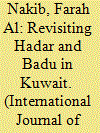

|
|
|
|
|
| Publication |
2014.
|
| Summary/Abstract |
Kuwait today is 99 percent urbanized. Though hosting a substantial desert population in the past, Kuwait no longer contains any Bedouin who practice a nomadic or pastoral lifestyle. And yet the term bad? remains in popular use in Kuwait to designate a group considered sociologically and culturally distinct from the ?a?ar, or settled urbanites, which in Kuwait's context refers solely to descendants of the pre-oil townspeople. This article explores why these social designations still exist in Kuwait and analyzes the origins of the conflictual relationship between the two groups. I argue that the persistence of the ?a?ar/bad? dichotomy is an outcome of state-building strategies adopted in the early oil years, mainly linked to citizenship and housing policies, that contributed to fixing ?a?ar and bad? as not only socially distinct but also geographically bounded groups. These state policies implemented between the 1950s and 1980s fostered the political integration but social exclusion of the bad?. The article examines the lived realities of these incoherent policies as one way of explaining how the bad? shifted from being the rulers' main loyalty base in the early oil decades to becoming their primary opposition today.
|
|
|
|
|
|
|
|
|
|
|
|
|
|
|
|
| 10 |
ID:
131514
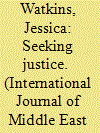

|
|
|
|
|
| Publication |
2014.
|
| Summary/Abstract |
In Jordan, tribal dispute settlements have played a Pivotal Role in the management of various types of grievances between individuals since long before the establishment of the modern state. To varying degrees, Jordanians-from the East and West Banks, Muslim and Christian, urban and rural-cherish the kinship networks associated with these procedures, and the ?a?wa (truce) and ?ul? (reconciliation) processes remain time-honored mechanisms for preventing revenge and making amends for wrongs committed. However, under the state's influence, the purpose of observing tribal settlements is evolving within an increasingly heterogeneous society. Drawing on documentary analysis combined with ethnographic material from across the kingdom, this article investigates the current status of tribal dispute resolution traditions among different sectors of the population. I argue that observance of such traditions can signify conformity with the hegemonic values that the state promotes as well as resistance to aspects of state control.
|
|
|
|
|
|
|
|
|
|
|
|
|
|
|
|
| 11 |
ID:
131546
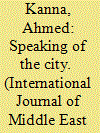

|
|
|
|
|
| Publication |
2014.
|
| Summary/Abstract |
The Arab Gulf remains a marginalized, even unfashionable, area of research in the Middle East academy. In spite of-or maybe because of-this marginality, the region offers an interesting vantage point for reflecting on the production of knowledge about geographic and cultural regions. The frame of knowledge production casts into relief discourses of "the city" in Middle East, and particularly Gulf, studies over the past decade.
|
|
|
|
|
|
|
|
|
|
|
|
|
|
|
|
| 12 |
ID:
131552
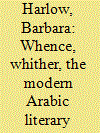

|
|
|
|
|
| Publication |
2014.
|
| Summary/Abstract |
Postwar Lebanon, Sufism, imperial translations, Hamlet, trials and atlases, city streets, literary cafés, and Tahrir Square: disorienting as these various themes might appear to be, they nonetheless entitle eight recent inquiries into contemporary-and precedent-directions of literary critical studies of the modern Arabic novel and their calculated revisions of, perhaps, another Arabic literary historical narrative that necessarily engages multigenre, comparative literary-historical investigations. Each of the works under review here was published between 2010 and 2013, with just one specifically, and that ex post facto, addressing the momentous events in Cairo's Tahrir Square in the early months of 2011. In other words, these works might well have already anticipated a more than seasonal, some would even argue historic, "Arab spring," and at least several of the works' authors found it necessary to append an epilogue to their in-production text, or otherwise slightly, subtly, revise at the last minute their presumptive chronologies and the contested trajectories of modern Arabic literature that attend them. From the classically proverbial "tradition versus modernity" discussions through their historicist implications for the cultural production of new media and alternative public spheres, each of these studies seeks, in its own way/s, to instantiate Arabic literature-and Arabic literary criticism-within and against its respected precursors. But where will that self-same literature, and its current critical mediations, eventually wind up, whether globally, nationally, or historically?
|
|
|
|
|
|
|
|
|
|
|
|
|
|
|
|
| 13 |
ID:
131540


|
|
|
|
|
| Publication |
2014.
|
| Summary/Abstract |
Designers and architects argue that interaction in public spaces is the product of relations between physical, cultural, social, and aesthetic components. As an art historian, my interest in and understanding of the production of public space is necessarily linked to its visual construction and to public art in particular. Urban planners have always included art in public spaces as a means of forming relationships between the people and the space. Governments have similarly understood the political significance of public space and its power to make meaning and have commissioned art accordingly. This essay reflects on the role of aesthetics and public art in the production and transformation of the modern public space in the Arab world by considering two examples from Cairo and Baghdad.
|
|
|
|
|
|
|
|
|
|
|
|
|
|
|
|
|
|
|
|
|